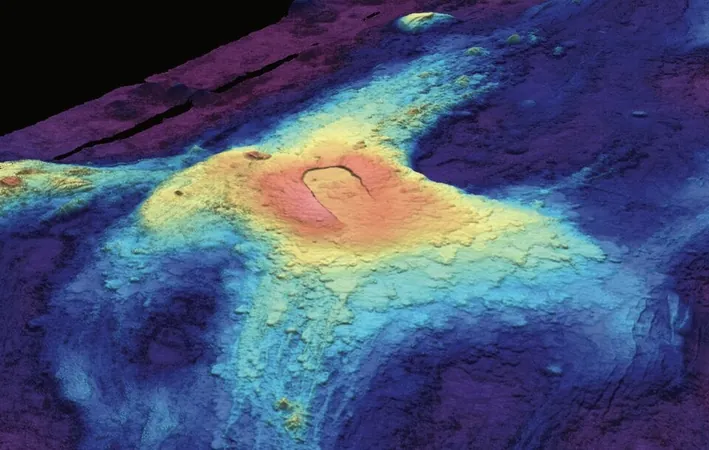
Is the Axial Seamount Ready to Blow? What This Underwater Volcano Could Teach Us!
2025-01-09
Author: Michael
Axial Seamount: An Active Underwater Volcano
Scientists are signaling potential explosive activity beneath the waves of the North Pacific, specifically at the Axial Seamount, the most active underwater volcano in the region. Located approximately 470 kilometers off the coast of Vancouver Island, this intriguing geological formation is gaining attention for its potential to provide crucial insights into volcanic behavior.
Shaped like a giant warrior’s shield, the Axial Seamount spans about 25 kilometers in width and stands at 1.1 kilometers tall, with its summit resting a staggering 1,400 meters below the ocean's surface. The volcano is capped by an enormous caldera and has fascinated researchers like Bill Chadwick from Oregon State University, who has dedicated years to studying its eruptions.
Recent Activity and Monitoring Efforts
"It’s truly remarkable," Chadwick exclaimed during a recent interview. "It's the most active submarine volcano in the northwest Pacific, even more so than those found on land." The Axial Seamount last erupted in 2015, and since early 2024, it has reignited with magma inflation after a period of dormancy. Chadwick led an expedition last June to equip the site with technology to capture any future eruptions. Now, data streams into research facilities onshore through an advanced undersea cable.
In December 2023, Chadwick revealed findings at an American Geophysical Union meeting, indicating the volcano has been rapidly inflating with magma alongside a surge in seismic activity—recording over 100 earthquakes daily since January 2024. These seismic events mark the shifting tectonic plates at the Juan de Fuca Ridge, where the Juan de Fuca Plate diverges from the Pacific Plate, allowing molten rock to percolate up and form the ridge.
Collaboration for Enhanced Understanding
Kate Moran, the CEO of Ocean Networks Canada (ONC), emphasized the importance of their real-time monitoring for seismic activity. Their sensors extend to the Endeavour segment, where active hydrothermal vents provide a vibrant ecosystem beneath the waves. Since March 2024, up to 200 earthquakes an hour have been tracked, prompting ONC scientists to develop contingency strategies should volcanic activity escalate.
"What we aim to do is ensure we have real-time sensors ready to track any magma emissions," Moran noted. The cooperation between ONC and Chadwick’s team allows for unique insights into geological processes beneath the ocean floor, potentially offering a clearer picture of how Earth's surface is formed and eroded.
The Potential for Future Eruptions
What's more, the Axial Seamount is positioned atop a magma hotspot, similar to the geological features that created the islands of Hawaii and Iceland. Between eruptions, magma accumulation has been observed to elevate the sea floor by up to 3.5 meters. "We believe we are nearing the next eruption cycle, with predictions pointing towards an event by the end of 2025," Chadwick stated confidently.
When an eruption does occur, it is expected that slow-moving lava will flow out of the caldera, creating vast deposits that could exceed 100 meters in thickness, while simultaneously generating new hydrothermal vents. "There’s a fascinating dynamic of death and rebirth with each eruption," Chadwick remarked.
Risk Assessment and Implications for Human Populations
Fortunately, the Axial Seamount poses little threat to nearby human populations. Experts believe it's unlikely to produce displacements that could trigger tsunamis, nor does it sit close enough to the Cascadia subduction zone to induce significant earthquakes.
In contrast, many land-based volcanoes in British Columbia and the Yukon remain dormant for centuries, with eruptions averaging every 200 years. For instance, Mount Garibaldi has not erupted for nearly 10,000 years and is expected to be explosive when it finally does. Experts warn that as volcanic risks are not well understood on land, focused studies are being intensified across British Columbia to better assess these threats.
Contributions to Global Volcanology
The regular eruptive patterns of the Axial Seamount are not just intriguing for researchers; they pose the potential for forecasting volcanic eruptions globally. Could the study of this underwater volcano lead to innovations that save lives during future eruptions? As Chadwick laid out, "The best way to understand volcanic behavior is to observe it in real-time."
Stay tuned as we continue to monitor the Axial Seamount—one of nature's most captivating mysteries—ready to reveal its secrets at any moment!



 Brasil (PT)
Brasil (PT)
 Canada (EN)
Canada (EN)
 Chile (ES)
Chile (ES)
 Česko (CS)
Česko (CS)
 대한민국 (KO)
대한민국 (KO)
 España (ES)
España (ES)
 France (FR)
France (FR)
 Hong Kong (EN)
Hong Kong (EN)
 Italia (IT)
Italia (IT)
 日本 (JA)
日本 (JA)
 Magyarország (HU)
Magyarország (HU)
 Norge (NO)
Norge (NO)
 Polska (PL)
Polska (PL)
 Schweiz (DE)
Schweiz (DE)
 Singapore (EN)
Singapore (EN)
 Sverige (SV)
Sverige (SV)
 Suomi (FI)
Suomi (FI)
 Türkiye (TR)
Türkiye (TR)
 الإمارات العربية المتحدة (AR)
الإمارات العربية المتحدة (AR)